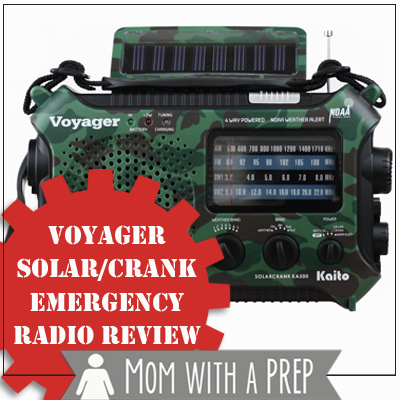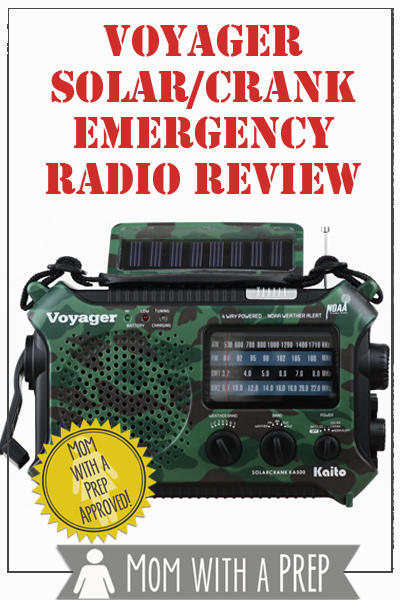One of the most basic of emergency preparedness items any family needs is a way to be able to get information on what is going on around them. Be it for weather updates, national crisis updates or even hearing music during times of strife, a radio is a great way to get that information. Having a radio that is not dependent on the ‘grid’ to get that information is also really important.
When my family began researching a weather radio when our old radio shack 40+ year old weather radio finally died, we had a different mindset. We wanted something that didn’t need to be plugged in, had greater capacity for receiving, and was able to be operated by something other than a battery was what we were shooting for. The Kaito Voyager Solar/Crank Emergency Radio fit the bill perfectly for us.
Gear Review: Kaito Voyager Solar / Crank Emergency Weather Radio
POWER OPTIONS: This radio can be plugged into an outlet, run off a battery (which we never seem to remember to check or keep supplies of), cranked or even solar charged. We have found that cranking for the full 2 min, and then leaving it on the NOAA/Weather alert option will give us sure reliability for power all night long in the event of tornadic weather in our area. What’s also great is that you can have batteries in, but choose to only run the radio/lights off the solar crank feature, thus saving the battery power.
However, the crank options take a lot of manual labor to keep the radio going, so this isn’t the best option unless it’s your only option. Keep it charged with the solar option and have batteries for a backup first.
CHARGING OPTIONS: The Voyager also allows for the charging of a cell phone or other small electronic through a USB port – so keeping it charged with solar power, and then charging a cell phone off of it is a great option for short-term emergencies when you cannot rely on the national grid for power, but don’t have a full solar set up to recharge.
RADIO OPTIONS: The Voyager radio gives options for bands such as AM/FM, NOAA, 2 short wave bands and a host of weather bands.
LIGHTING OPTIONS: One great feature about the Voyager radio is that it also gives you 3 lighting options. You have a flashlight, an emergency strobe, as well as a short-distance area light.
Weighing in at around two pounds, this may not be a radio you want to tuck in your bug out bag if weight and space are a priority. And we all know that having more options on tools just leads to more chances of problems, but this solar radio is a powerhouse. We keep it handy to pull out during bad weather season, can be placed anywhere we need it to be, is set so that the NOAA station can be put on standby, only going off when a new alert is set for your area, and also provides another lighting option for us if the power goes out. The added benefit of being able to charge a cell phone from it if we have an extended power outage so that we’re still able to communicate is a great benefit, as well.
Some disadvantages – we have a hard time getting AM/Short Wave depending on where we are in the house and if other electronics are on. It does not come with the 6V charger (which is should for the price), and while the crank is great for the NOAA alert, we find that we do want to rely on batteries for full charge options, as the crank can get tedious over long-term use. While the body feels like cheap plastic, it’s gotten banged around pretty well and never cracked or broken on us.
All-in-all we really like this radio and the features that it offers. We usually recommend it to anyone who asks about for the all-around options it adds for weather-related emergencies in our area.
Share your thoughts — do you have an emergency radio for your house, yet?
Katy Willis is a writer, lifelong homesteader, and master herbalist, master gardener, and canine nutritionist. Katy is a preparedness expert and modern homesteader practicing everyday preparedness, sustainability, and a holistic lifestyle.
She knows how important it is to be prepared for whatever life throws at you, because you just never know what's coming. And preparedness helps you give your family the best chance to thrive in any situation.
Katy is passionate about living naturally, growing food, keeping livestock, foraging, and making and using herbal remedies. Katy is an experienced herbalist and a member of the CMA (Complementary Medical Association).
Her preparedness skills go beyond just being "ready", she's ready to survive the initial disaster, and thrive afterward, too. She grows 100% organic food on roughly 15 acres and raises goats, chickens, and ducks. She also lovingly tends her orchard, where she grows many different fruit trees. And, because she likes to know exactly what she's feeding her family, she's a seasoned from-scratch cook and gluten-free baker.
Katy teaches foraging and environmental education classes, too, including self-sufficient living, modern homesteading, seed saving, and organic vegetable gardening.
Katy helps others learn forgotten skills, including basic survival skills and self-reliance.
She's been published on sites such as MSN, Angi, Home Advisor, Family Handyman, Wealth of Geeks, Readers Digest, and more.




